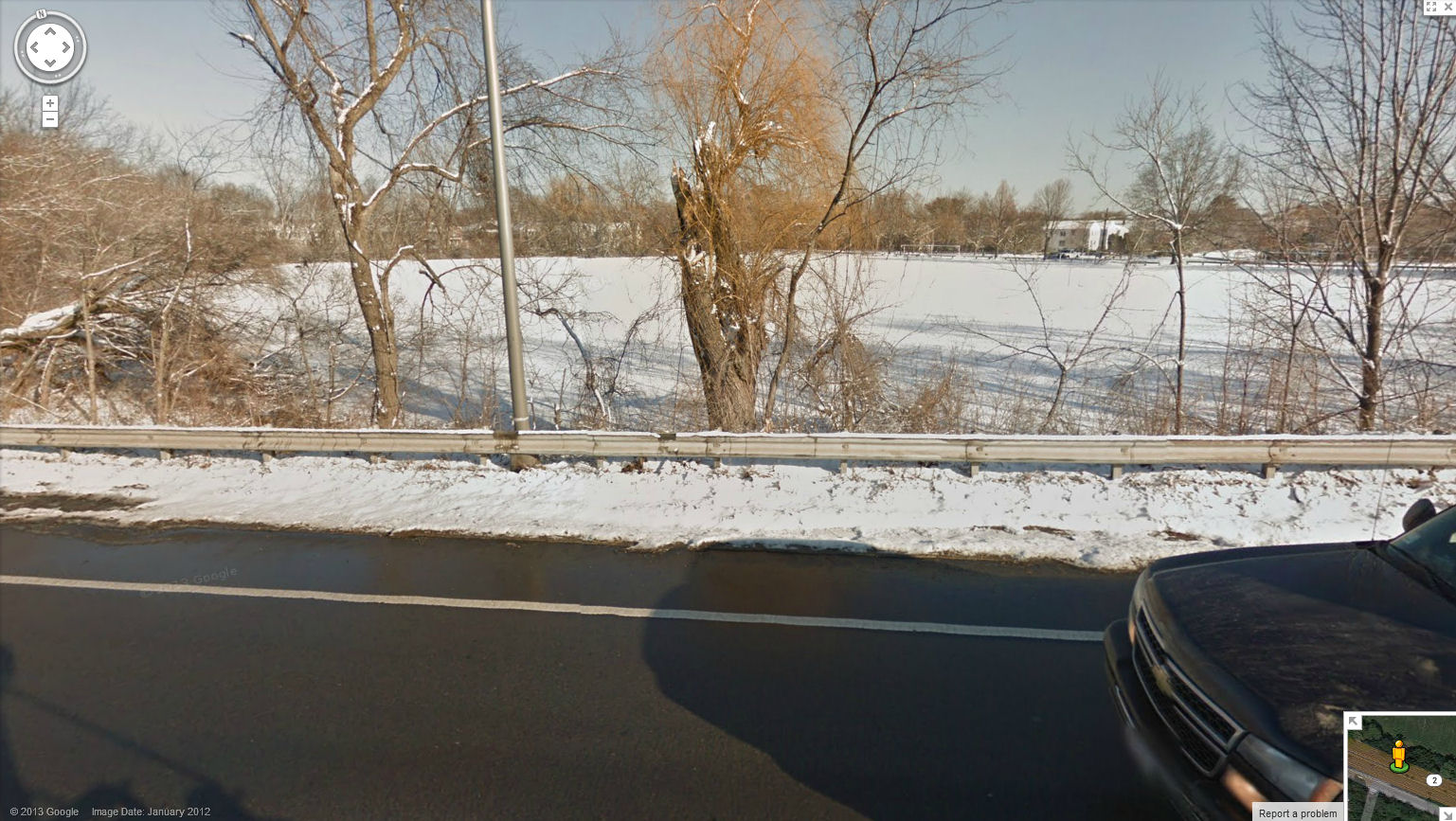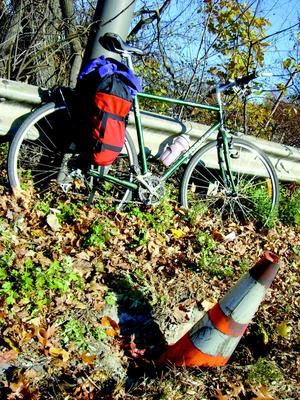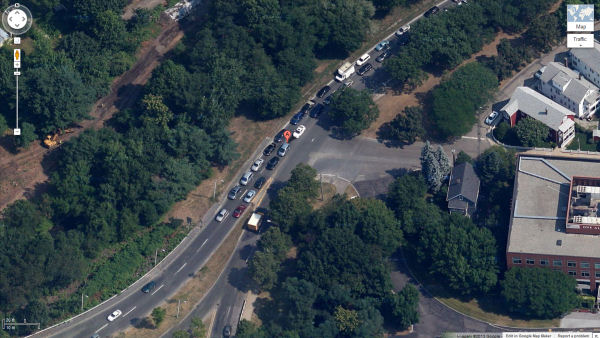Bob Zeeb was a teacher in the Newton Public Schools, a colleague of my wife’s. I feel compelled to set the record straight about his unfortunate death in a bicycle crash on November 10, 2009.
From an e-mail message sent out today by Livable Streets:
Bike4Life was founded by the Zeeb family in memory of Bob Zeeb who died in an avoidable bicycle incident in 2009 caused by poor signage and road conditions. Sponsor the Zeeb family (photos below) or another rider to help improve our roads and keep our loved ones safe.
The most detailed news reports I’ve seen of this crash including a photo of the bicycle at the crash scene, are from the Arlington Advocate. (The Advocate from 2006 forward is available online with an Arlington library card, or on microfilm. The relevant articles are not available in the Internet Archive).
Quoting:
Robert Zeeb of Newtonville was cycling from Alewife Brook Parkway toward Lake Street, when it appears his bike struck a hole containing a submerged electrical box that was missing its metal top, said State Police spokesman David Procopio.
[…]
Shortly after the accident, the stretch of sidewalk was partially covered in leaves and an orange safety cone stuck out of the concrete hole. It is not clear at this point if the safety cone was there before the accident. A metal MassHighway lid for the electrical box lay a foot or so away.
Also see the Boston Globe article included in a Harvard Class of 1960 newsletter [archived].
The crash occurred on the sidewalk along the north side of Route 2 shown in this Google satellite view — in the section where there is a guardrail, and directly under a streetlight pole.
The crash had nothing at all to do with bad road conditions — it happened on a sidewalk — or for that matter, with any ordinary bad sidewalk conditions. The crash may have resulted from vandalism, or a motor vehicle’s having dislodged the utility box cover. Another possibility is that the box cover was left open by workers updating signage, as reported in the Advocate, but this isn’t a usual issue with signage. The MassDOT record of the project [archived] mentions nothing about lighting, and the nearest sign is hundreds of feet away.The orange safety cone raises unanswered questions, though it is hard to imagine why anyone working on an electrical box in a sidewalk wouldn’t simply put the cover back when finished. Did the police place the cone following the crash?
Oddly enough, Livable Streets has a different, more nearly accurate explanation for the crash on a Web page:
Bob was regularly cycling 50 miles a day and hoped to make a cross-country trip in the summer of 2011. He died November 10, 2009, as the result of a bicycle accident due to a missing electrical utility vault access plate.
Yes, signage and road conditions could be improved, and so could sidewalk and path conditions, but I find today’s e-mail inaccurate, and a distraction from the true story which might identify why the crash occurred, even at this late date. The e-mail also would lead uninformed readers to the conclusion that the fatality resulted from a collision with a motor vehicle, promoting fear of riding on the roads where, instead, it should serve as a lesson to avoid riding through leaves, a puddle, mud, snow etc. where the riding surface is not visible.
Postscript, September 20, 2013:
This Google Street View from January, 2012, and this from November of that year include the utility pole, large tree trunk and odd, angled sapling in the Arlington Advocate photo and pinpoint the location.
In case Google updates its Street View, here is the one from January, 2012:

Here’s the Advocate photo. (There was a larger version of it in the article).

A few more thoughts have occurred to me:
An Advocate article indicates that the front wheel was scuffed, and in the Advocate photo, the wheels of the bicycle appear intact, suggesting that Zeeb crashed not from the front wheel’s going into the hole, but from its being deflected by the cover plate. If the orange safety cone was in the hole before the crash, it is unlikely that Zeeb rode into the hole. He would probably have ridden far enough to one side or the other for a pedal to clear the safety cone.
One end of the sidewalk was opposite Whittemore Avenue in North Cambridge, and the other end was at a pedestrian overpass over Route 2. There were no connections in between. The sidewalk apparently served to connect West Cambridge with a business district on the south side of Route 2, before the Alewife MBTA station project made other connections in the early 1980s. The sidewalk was in rough condition except where it was rebuilt on the new bridge over the Minuteman Commuter Bikeway in 2001-2004. (Also see Street View.)
Also, as is very common in Massachusetts, the sidewalk was between the guardrail and the roadway. Though no motor vehicle was directly involved in Zeeb’s crash, the guardrail placement may have allowed a motor vehicle to dislodge the cover plate.
The sidewalk was already deteriorating at the time of the crash, and continued to deteriorate. As of 2017, the hazard of using the sidewalk was eliminated, by eliminating the sidewalk in favor of a wider road shoulder. (See Google Street View from September, 2017.)
Where was Zeeb coming from? Where did he intend to go? In which direction was he traveling?
It is striking just how difficult this stretch of sidewalk was to reach.
At its east end, there was no traffic signal, crosswalk or wheelchair ramp to ease the crossing of Alewife Brook Parkway. A cyclist could possibly also reach the east end in the parkland between Alewife Brook and the Parkway, or on the Parkway, or from Alewife Station via the ramp to the intersection of Route 2 and the Parkway. The last two options involve riding on busy multi-lane arterials and are not very consistent with continuing the ride on a sidewalk or with discretionary, pleasure riding. (See Google satellite view. Alewife Brook is under the trees at the left, and past it, the new greenway is shown, under construction as of the date this image was captured. I’ve copied the image below because Google renews its imaging from time to time.)

To enter or leave the west end of the sidewalk, a cyclist would have to ride along Route 2, then carry the bicycle up and down the stairways at the deteriorating pedestrian overpass, or else know how to reach and follow an unmarked path in the woods. (See Google Street View. I’ve copied the Street View image, below, as it may be replaced in time. The overpass was still in place and accessible as of October, 2023.)

In the Advocate photo, the bicycle has been moved since the crash, but it is facing east. Was Zeeb riding westwards, as news reports suggest? Witness statements might provide an answer.
If Zeeb wanted to go to the Minuteman Commuter Bikeway, then perhaps he did not know that this sidewalk did not connect to it. Zeeb was retired; he had time on his hands; he rode 50 miles per day. Wouldn’t he already know of the numerous other ways to reach the Minuteman? Perhaps he was just exploring?
The problem, however, is not one of signage, because it is not usual to post signs indicating where a route does not go.
The new Alewife Brook Greenway, installed since Zeeb’s crash, improves the connection from Massachusetts Avenue to the Minuteman Commuter Bikeway on the north side of Alewife Brook but it did not connect to the sidewalk. I’ve advocated in the past for a more direct connection between the Linear Park in Cambridge and the Minuteman Commuter Bikeway.
It would be very interesting to see the report on the investigation, which might shed some light on questions about this crash.
[Arlington Advocate and Google content are included under fair use provisions of US copyright law.]

Leave a Reply
You must be logged in to post a comment.